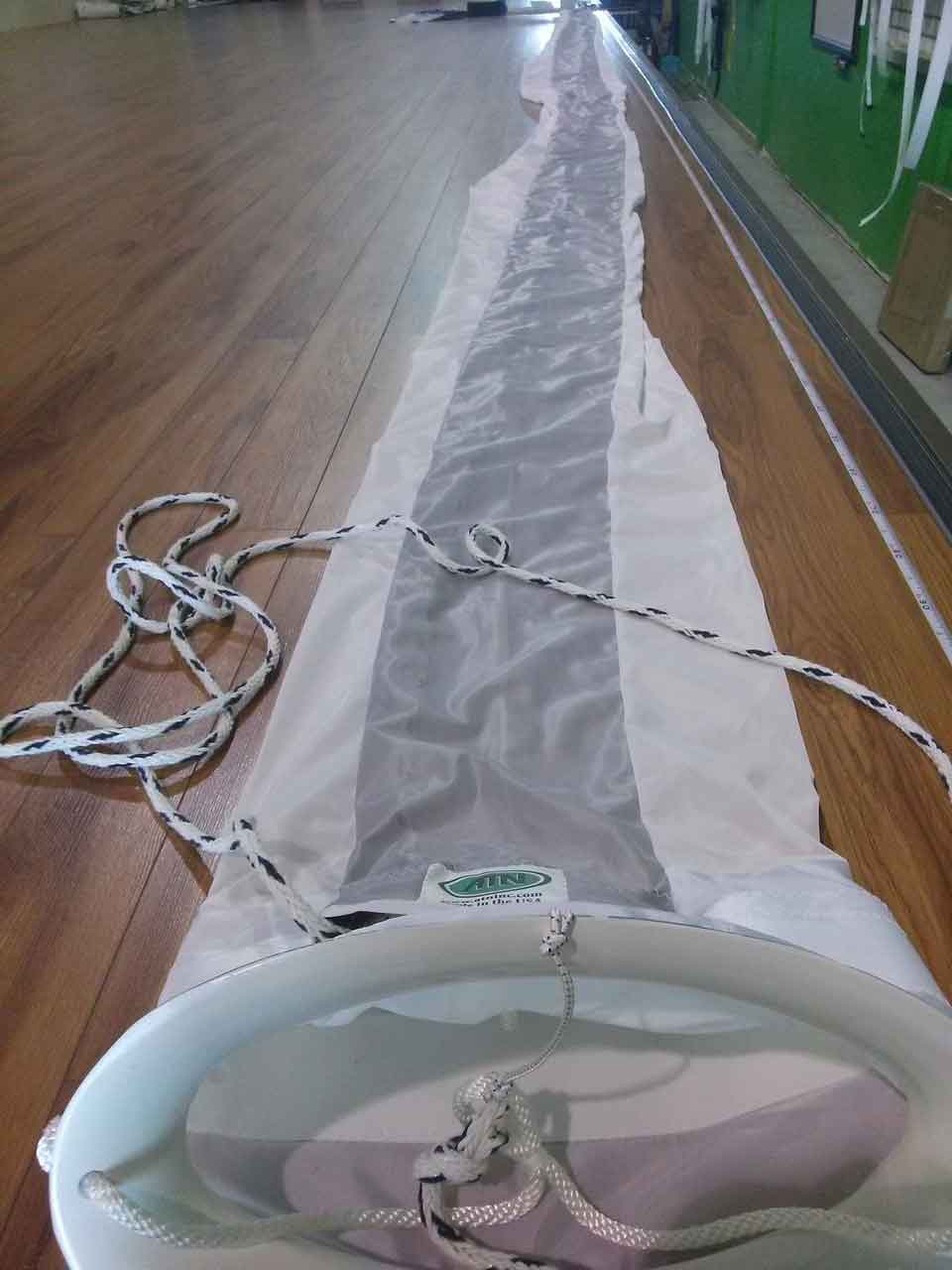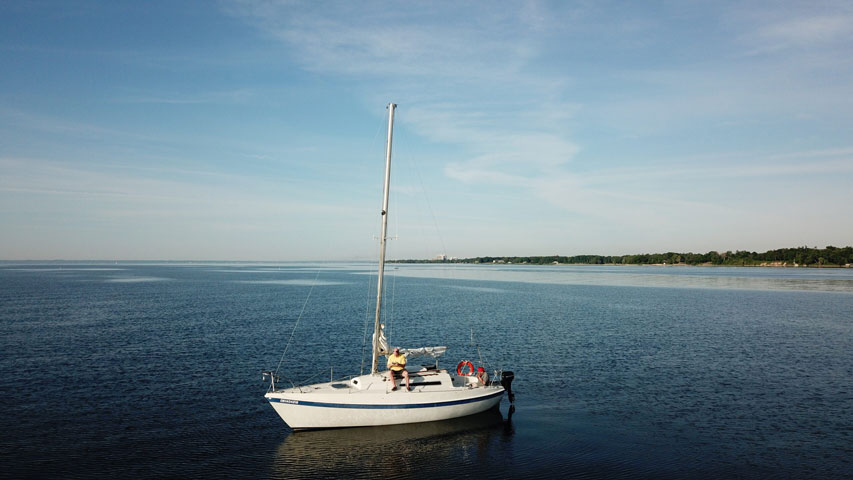A spinnaker is downwind sail set at the bow which billows when it catches the wind. Lightweight and custom made for the wind range you plan to sail in. All of our spinnakers are radial designed and stitched together expertly to prolong their life.
Symmetrical
A symmetrical spinnaker, as it sounds, is balanced and proportional. Both sides of the sail are mirror images of each other. Making the luff and Leech the same length. This makes a symmetrical spinnaker ideal for dead down-wind runs or broad reaches. When using a symmetrical spinnaker on a catamaran you may not need to use a spinnaker pole to offset the tack, however, monohulls will find a pole or spinnaker tacker necessary for use.

Sailing Nahoa Flying Their Symmetrical Spinnaker
Rigging
Controlled by sheet and guy lines from the Tack and Clew. The guy is attached to the Tack and is steadied by a pole. The sheet is attached to the clew and controls the shape of the sail. These lines will be interchanged when gybing. Lines should be run outside of the rigging and lifelines, to blocks and then winches for trimming.


Red Is The Guy Line | Green Is The Sheet
The spinnaker pole should be parallel to the water/deck and set to the opposite side of the boom to avoid hitting the forestay.
On some catamarans, a pole is not necessary for dead down-wind sailing as the clew and tack can be run to blocks at either side of the front of the boat. A spinnaker tacker can also be used to fly a symmetrical like an asymmetrical without a pole.

Gybing and Trimming
Trimming your symmetrical spinnaker is mostly done with the sheet rather than the guy line. Keep an eye on the edge of the sail. If you notice it beginning to curl that means you are pointing too high. This can overpower your boat and cause you to sail through your apparent wind causing the spinnaker to go slack. If this happens you can either adjust the tension on the sheet and guy or drop off and continue heading downwind.
When you need to gybe, disconnect the pole from the mast and the guy line, this is often done by pulling a wire on the pole itself. Once disconnected flip the pole around making sure it is on the other side of the forestay. Connect the post-mast clamp to the old sheet, which will now become the guy line. Clip the other end (post-guy line side of the pole) to the mast. Tighten up the sheet and guy lines to trim in the new position. Gybing with a symmetrical spinnaker is easy to do with some practice and can typically be handled by a short handed crew as long as they have practiced and have a plan.
Asymmetrical
An asymmetrical spinnaker has a dedicated tack and clew with a variation between the length of the luff and leech. Asymmetrical spinnakers are capable of handling a much wider range of angles and are ideal for running and broad-reaching. They do not require a spinnaker pole or tacker to use.

Rigging
As with a symmetrical spinnaker, the head attaches to your spinnaker halyard. Attach the Tack using a tackline running to a bowsprit block and run the line back to the cockpit to a halyard winch. In lighter winds, the tackline should be trimmed to be brought closer to the deck for better performance. If you do not have a bowsprit block you can DIY a block in front of the pulpit. All sheets should be run outside of lifelines to blocks and then to winches at the aft.Unlike a symmetrical spinnaker, the clew of the asymmetrical has two sheets. One is the lazy sheet, waiting to be used, and the other is the sheet used for trimming. Both sheets will run from an aft winch to a block outside of the lifelines up to the bow on each side. Because the lazy sheet must pass around the forestay to the clew position on the other side both sheets must be long to accommodate gybing.

The Tackline Connecting The Tack To A Block
Gybing and Trimming
Watch the edge of the sail for any curl. Loosen the sheets or adjust course to maintain sail shape. If you notice your sail is luffing you will need to pull the sheets in.
To Gybe with an asymmetrical ease the sheet on a broad reach, before turning onto a run and letting the sheet off. The Clew of the sail will now pass between the tack and the forestay. Tighten the lazy sheet as the sail luffs and trim accordingly. The old sheet will now become the lazy sheet.
Packing a Spinnaker
To efficiently launch a spinnaker from a turtle bag, some preparation is needed to make sure that twist does not occur. Because spinnakers are such large and powerful sails the goal of packing the spinnaker is for it to billow out and open quickly. Hold the Clew and Tack together and begin stuffing the excess material into the bag. Make sure that the leech and luff are coming together before being stuffed into the bag. By folding the spinnaker in half like this you will minimize errors when launching. Keep stuffing the spinnaker into the bag until all three corners are coming out of the top. Clip the turtle bag to your lifelines and you are good to go.
A Spinnaker Sock does not require you to pack the sail away as it gathers and contains the spinnaker as it is lowered.
Tip: Keep the Head, Tack, and Clew organized with clear labels.
Dousing the Spinnaker With a Turtle Bag
When you are finished with the spinnaker ease the sheets and release the halyard to begin lowering and stuffing the sail into your bag. Make sure to pack the spinnaker away so that you can easily use it again when needed.

Dousing the Spinnaker With a Sock
Ease the sheets and lower the sock. Once it has contained the spinnaker lower the sock and stuff it into a bag for easy storage and management.

Ready to Hoist (Symmetrical Spinnakers)
Attach the Spinnaker Pole
Clip the pole to the mast with its jaws facing up. Use the ring in the middle to attach the topping lift and attach the downhaul to the ring on the bottom. This will keep tension on the pole and keep it in the right position.
Connect the Sheet, Halyard, and Guy lines
Connect the other end of the pole to the guy line. This will become the tack of the sail. Run the sheet to the other corner of the spinnaker and attach the halyard to the head of the sail. Double-check to make sure your lines are tangle-free.
Raise Pole into Position
Raise the topping lift and tighten the down-haul until the pole is horizontal with the water/deck.
Hoist the Halyard and Trim
Hoist the spinnaker using the halyard and tighten the guy line to trim the spinnaker and position of the pole. The spinnaker should billow and open up but a little twist in the sail will free itself.
When using a spinnaker sock hoist the sock, ease the sheets and then release the spinnaker by raising the snuffer. Tension and trim appropriately to avoid twist.
Ready to Hoist (Asymmetrical Spinnakers)
Prepare the Tack and Tackline
Attach the Tack to the Tackline and trim it to the height required.
Raise the Halyard
Raise the Halyard and let the sail billow out. If you are using a spinnaker sock hoist the sock and then raise and tie off the snuffer to open the sail.
Alter Course and Trim
Once your spinnaker is hoisted maintain a good course and trim the sheet and tackline.

If your looking to get a new spinnaker, click the button below. To learn more about spinnakers click here.



